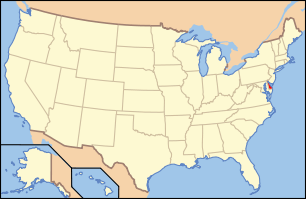Ethel S. Roy House
|
Vernacular Frame House | |
|
House in 2011 | |
  | |
| Location |
105 Clarks Corner Rd., St. Georges, Delaware |
|---|---|
| Coordinates | 39°33′24″N 75°38′53″W / 39.55673°N 75.64815°WCoordinates: 39°33′24″N 75°38′53″W / 39.55673°N 75.64815°W |
| Area | 0.5 acres |
| MPS | Red Lion Hundred MRA |
| NRHP Reference # | 82002359[1] |
| Added to NRHP | April 8, 1982 |
The Ethel S. Roy House is a historic building identified simply as Vernacular Frame House when listed on the National Register of Historic Places in 1982 as part of the Red Lion Hundred Multiple Resource Area.[2]
The house was built c. 1868 by a former slave and was singled out for historic preservation in an effort to counteract the bias that only homes of the affluent are recognized as being historically significant. It represents a working man's home in a labor-intensive agricultural society and has had few alterations since it was built.
Red Lion Hundred is an area of New Castle County, Delaware roughly equivalent in size and function to a township. It was settled in the seventeenth century, with the soil being ruined by intensive tobacco cultivation by 1800. A "peach boom" lasted from about 1830 to 1870 until a blight called "the yellows" destroyed the peach crops. Slavery provided labor in the area until the American Civil War.
The Roy House was built soon after the Civil War by a former slave, whose granddaughter lived in the house until at least 1979. It is located just north of the unincorporated village of Saint Georges, Delaware, on a 150 foot square plot of land once owned by the locally prominent Sutton family.
It is a wooden frame two-story, two-bay house with gabled roof which had a small enclosed front porch. Photographs taken in 1970 or 1979[3] show a simple building with wooden siding, a tin roof, six-over-six windows, and an interior chimney on the south end. The single decorative item appears to be a "gothic" attic window with a "pointed arch" above a rectangular window. A photograph from 2011 shows that the roof, siding and windows have been recently replaced, the porch opened up, and the chimney removed.
See also
References
- ↑ National Park Service (2010-07-09). "National Register Information System". National Register of Historic Places. National Park Service.
- ↑ Richard Jett and Gretchen Fitting, 1979, Red Lion Hundred Multiple Resource Area, National Register of Historic Places Nomination Form. See especially p. 29.
- ↑ Photos of Vernacular Frame House, National Register of Historic Places.
External links
- Google Streetview, retrieved December 16, 2011.

